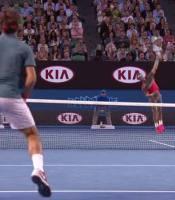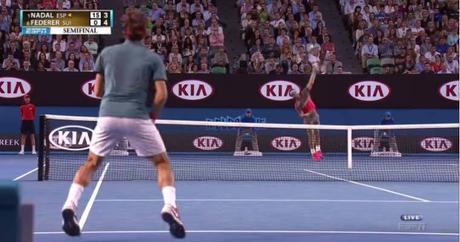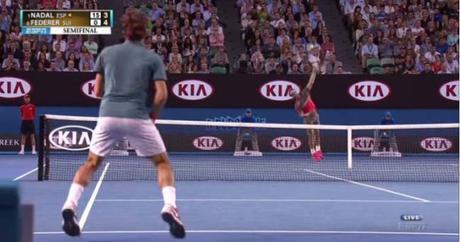

 Federer split steps as Nadal serves
In tennis, the split step in tennis is one of the most important of footwork techniques, and definitely one of the most overlooked – especially by recreational players. It’s a small move, but when timed perfectly, makes a BIG difference on how well you return the ball.
Federer split steps as Nadal serves
In tennis, the split step in tennis is one of the most important of footwork techniques, and definitely one of the most overlooked – especially by recreational players. It’s a small move, but when timed perfectly, makes a BIG difference on how well you return the ball.
What is a split step?
A split step isn’t a “step” at all, but a small hop that you take from the ready position as your opponent hits the ball. This subtle movement engages your body, getting it ready to move toward the incoming ball while providing the balance you need to react to any changes of angles, pace, and trajectory.It sounds a little confusing, I know, so I’ll let the incredible Roger Federer demonstrate it in this video clip:
Notice that when Federer does his split step, he takes a small hop (just an inch or so off the court) with both feet, and then lands on both feet in roughly the same place that he started. The key factor here is that as he lands, he almost “bounces”. He keeps most of his weight a little forward and on the balls of his feet, and then bends his knees slightly so that he can push off explosively in the direction of the tennis ball. This is SO much more effective than being flat-footed when receiving the ball.
When do I split step?
Start your split step as your opponent swings her racket forward to hit the ball. In other words, you should be coming off the ground at soon as you see the open face of her racket as it makes contact with the ball. Don’t worry if your timing is a little bit too early (ie. if she hits a loopy topspin ball) because the hop is so quick and low to the ground, you’ll have plenty of time to split step again to get your timing right. Advanced players might execute the split step 2-3 consecutive times before finally making their move to the ball (as Federer did in the above video).Must I split step on every shot?
While the the split step should be your first reaction to every ball you return – including volleys – there will be times it isn’t necessary, like when you’ve been run off the court and are in a defensive position. In that instance, there is no time to spare, so it’s best to just run the ball down and return it deep enough so that you have time to get back into position and stay in the point.
Like everything in life, the split step takes practice for it to become a habit, and there are a couple of good ways to do it. One is to practice by hitting groundies and returns of serve with a partner, rather than a ball machine or wall. That way, you can get used to timing your hop with someone swinging a racket, rather than a ball coming out of a machine or off a wall. Have your partner hit a variety of serves and strokes – hard and flat, lots of topspin, lots of slice, etc. and keep the ball in play, focusing only on your split step. This is good practice for your partner too, as she can either also work on her split step, as well as her consistency of serve and returns. Another thing you can do is jump rope. I know it doesn’t directly involve the split step, but it does help get your legs used to the “bounce”.
That’s it, peeps! Work on your split step and timing, and take your game to a whole new level!

